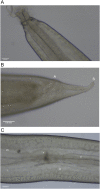Ascaridoid nematodes infecting commercially important marine fish and squid species from Bangladesh waters in the Bay of Bengal
- PMID: 35518125
- PMCID: PMC9065311
- DOI: 10.1016/j.fawpar.2022.e00157
Ascaridoid nematodes infecting commercially important marine fish and squid species from Bangladesh waters in the Bay of Bengal
Abstract
Parasitic ascaridoid nematodes occur in a wide range of marine organisms across the globe. Some species of the anisakid family (Ascaridoidea: Anisakidae) can cause gastrointestinal disease in humans (i. e. anisakidosis). Despite their importance as potentially hazardous parasites, the occurrence and infection characteristics of ascaridoids are still poorly known from many host species and geographical areas. This study investigated the diversity and infection levels of ascaridoid parasites in various commercial fish and squid host species off Bangladesh. Fish and squid specimens were visually inspected for nematodes using the UV-press method. Nematodes were assigned to genus level based on morphology and identified by sequence analyses of the entire ITS region and partial 28S rDNA and mtDNA cox2 genes. Third-stage larvae (L3) of Anisakis typica occurred at low prevalence (P = 10% and 8%, respectively) in the viscera of Selar crumenophthalmus and Trichiurus lepturus, while Hysterothylacium amoyense occurred in the viscera of Sardinella fimbriata (P = 1%) and the viscera and muscle of Harpadon nehereus (P = 32%) and T. lepturus (P = 76%). Lappetascaris sp. Type A L3 occurred in the mantle of the squid Uroteuthis duvaucelii (P = 11%). Anisakis and Lappetascaris species, and H. amoyense were firstly identified in the Bay of Bengal. The potentially zoonotic A. typica was only found in fish viscera. Hysterothylacium amoyense and Lappetascaris sp., both generally regarded as non-zoonotic, occurred at low prevalence in the muscle or mantle of fish or squid, respectively. Since consumption of raw or lightly processed seafood seems to be rare in Bangladesh, the risk of acquiring anisakidosis from consuming fishery products from off Bangladesh appears to be low. Due to its reddish appearance, the visual presence of H. amoyense larvae in fish flesh may represent a food quality issue.
Keywords: Anisakiasis; Anisakis; Bay of Bengal; Fish parasite; Hysterothylacium; Lappetascaris.
© 2022 Published by Elsevier Inc. on behalf of International Association of Food and Waterborne Parasitology.
Conflict of interest statement
The authors declare that they have no known competing financial interests or personal relationships that could have appeared to influence the work reported in this paper.
Figures




Similar articles
-
Anisakid nematodes in Trichiurus lepturus and Saurida undosquamis (Teleostea) from the South-West Indian Ocean: Genetic evidence for the existence of sister species within Anisakis typica (s.l.), and food-safety considerations.Food Waterborne Parasitol. 2022 Aug 23;28:e00177. doi: 10.1016/j.fawpar.2022.e00177. eCollection 2022 Sep. Food Waterborne Parasitol. 2022. PMID: 36072478 Free PMC article.
-
Occurrence of larval ascaridoid nematodes in the Argentinean short-finned squid Illex argentinus from the Southwest Atlantic Ocean (off Falkland Islands).Int J Food Microbiol. 2019 May 16;297:27-31. doi: 10.1016/j.ijfoodmicro.2019.02.019. Epub 2019 Feb 28. Int J Food Microbiol. 2019. PMID: 30870722
-
Detection of ascaridoid nematode parasites in the important marine food-fish Conger myriaster (Brevoort) (Anguilliformes: Congridae) from the Zhoushan Fishery, China.Parasit Vectors. 2018 May 2;11(1):274. doi: 10.1186/s13071-018-2850-4. Parasit Vectors. 2018. PMID: 29716661 Free PMC article.
-
Anisakis Nematodes in Fish and Shellfish- from infection to allergies.Int J Parasitol Parasites Wildl. 2019 Jun 6;9:384-393. doi: 10.1016/j.ijppaw.2019.04.007. eCollection 2019 Aug. Int J Parasitol Parasites Wildl. 2019. PMID: 31338296 Free PMC article. Review.
-
Presence of Anisakidae in commercial fish species imported into the Belgian food markets: A systematic review and meta-analyses.Int J Food Microbiol. 2020 Apr 2;318:108456. doi: 10.1016/j.ijfoodmicro.2019.108456. Epub 2019 Nov 21. Int J Food Microbiol. 2020. PMID: 31821936
Cited by
-
Anisakid nematodes in Trichiurus lepturus and Saurida undosquamis (Teleostea) from the South-West Indian Ocean: Genetic evidence for the existence of sister species within Anisakis typica (s.l.), and food-safety considerations.Food Waterborne Parasitol. 2022 Aug 23;28:e00177. doi: 10.1016/j.fawpar.2022.e00177. eCollection 2022 Sep. Food Waterborne Parasitol. 2022. PMID: 36072478 Free PMC article.
-
A contribution on first report of morphogenetic characterization of Anisakis typica parasitizing Indian sand whiting, Sillago sihama from Central west coast of India.Helminthologia. 2024 Dec 12;61(3):232-243. doi: 10.2478/helm-2024-0027. eCollection 2024 Sep. Helminthologia. 2024. PMID: 39679326 Free PMC article.
References
LinkOut - more resources
Full Text Sources
Research Materials

